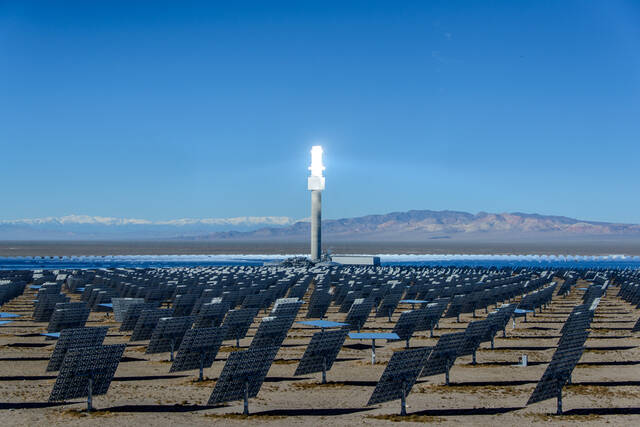NEVADA VIEWS: Golden opportunities in the Silver State
Since early this year, the national conversation about energy security has been supercharged, as has interest in domestic renewable energy sources. Nevada is at the forefront of these discussions, and rightly so.
In 2021, renewable energy resources accounted for 33 percent of Nevada’s in-state electricity net generation. Open deserts and a strong mining industry combine to give Nevada the greatest potential for solar energy of any state in the country, something I saw firsthand as the commanding officer at Nellis Air Force Base shortly after the Nellis solar power plant began operations. There are numerous golden opportunities for renewable energy in the Silver State, which positions Nevada to lead both the region and the country in widespread adoption of renewable energy technologies.
Solar energy already plays a large role in Nevada’s energy supply, and expanding solar capacity even further remains crucial to decarbonizing Nevada’s energy sector. In order to make this expansion possible, the state must be able to source necessary materials for the construction of solar photovoltaic cells, the most critical of which is lithium.
The United States currently relies on foreign sources of lithium, with most imports coming from Chile and Australia. The two countries combined produce nearly 60 percent of lithium globally. Naturally, establishing a domestic source of lithium is part of a larger U.S. strategy to develop domestic supply chains for critical minerals.
Both the Trump and Biden administrations have enacted policies that direct U.S agencies to develop domestic sources. Those efforts hit home in Nevada earlier this year when the Nevada Division of Environmental Protection issued final air, water and mining permits to the proposed Thacker Pass mine project in Humboldt County. Operated by Lithium America, the project is poised to become the center of an American lithium boom.
Conversely, while Nevada is leading in harnessing the power of the sun and seizing its potential as the only state in the union with an operational lithium mine, Nevada is lagging on capturing the power of wind, which accounts for less than 1 percent of the state’s energy generation. Nevada is currently 33rd in the nation in wind energy production and is the No. 7 state with untapped wind potential.
Nevada’s scattered mountain ridges and slopes have the state’s greatest wind potential, but there is only one utility-scale wind project online in the state: the 150-megawatt Spring Valley wind farm near Ely. Sunlight is everywhere, and winds tend to be gusty and not consistent. But advances in wind turbine technology have started to mitigate this issue — even though wind isn’t always present, turbines can still actively generate energy 90 percent of the time through the use of stored energy surpluses.
Nevada has a unique opportunity to safely and effectively play a crucial role in the clean energy transition while simultaneously laying the foundation for resilience. Its whole-of-government approach, highlighted at a recent American Security Project event, is bringing together private industry, government, local and tribal authorities and key research partners to facilitate and expedite progress.
Through innovative approaches and institutions such as the Nevada Clean Energy Fund, combined with a careful approach to protect Nevada’s vital military capabilities at Nellis, the Fallon Naval Air Station and the Hawthorne Army Depot, the state is working to improve its infrastructure, forecasting and resource allocation, and will no doubt set an example for other states and the U.S. more broadly.
Col. David Belote, U.S. Air Force (Ret.), is former commander of Nellis Air Force Base and a member of the Consensus for American Security network.




























